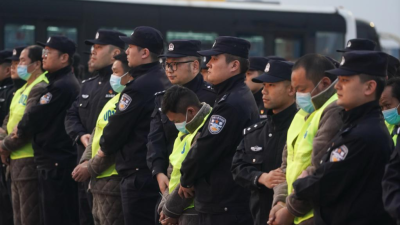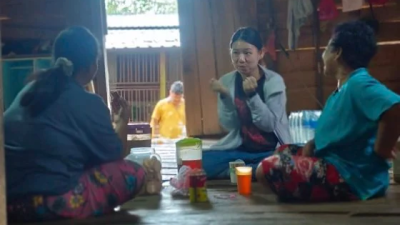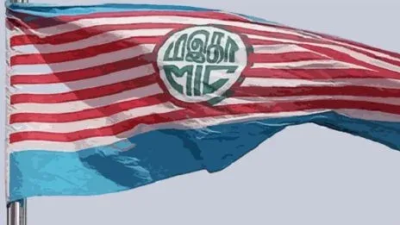Classical Indian dances are extremely rich in body language, with over 20 different gestures that can be maneuvered with a single hand alone, not to mention countless of different movements of the head, neck, hips and legs going concurrently in synergy for infinite expressions of human emotions and all things on Earth, living or dead.
‘Every move has its significance’
Indian dances that many of us know about are works from Bollywood movies, thinking that Indian dances are all about a large entourage of men and women singing and dancing in a raucous party-like atmosphere.
This, in reality, is just one of the many types of Indian dances tailored to entertain the audiences. In India, there are also time-honored classical dances that can be subdivided into not fewer than six different forms each of which has its own specifications and meanings.
The most commonly seen classical Indian dance forms are Bharatanatyam, Odissi, Kathak and Kuchipudi, of which Bharatanatyam has been incorporated into the dance curricula of some tertiary institutions here.
This explains why it has become the most familiar dance form among many people in Malaysia, in particular non-Chinese.
Elaine Ng Xinying, faculty of dance lecturer at the National Academy of Arts Culture & Heritage (ASWARA), is specializing in Bharatanatyam dance.
If you break up the word Bharatanatyam, she said, you will get “bha” for bhava which means emotion, “ra” for raga which means melody, “ta” for tala which means rhythm, and “natyam” which means dance and drama.
In essence, Bharatanatyam is a concoction of emotions, melodies, rhythms, dances and dramas.
If you must use a single element to describe Bharatanatyam, Elaine said that must be “fire” because the dance is so powerful and energetic yet absolutely “down-to-earth”, meaning there will not be too many high jumps or elaborate movements, with the legs constantly maintained at an aramandi semi-squat posture with the knees bent outward and both arms parallel with the shoulders.
Elaine admitted that Bharatanatyam could be very taxing for the dancer, as the limbs have to be kept at almost the same position for extended period of time.
What then is the significance of a Bharatanatyam dance? Why do the moves, gestures and facial expressions always look so dramatic?
Elaine explained that this had to start with the origins of the dance.
Manifestations of emotions and all things on Earth
Like many other classical Indian dances, Bharatanatyam had its origins in the temple with the objective of interpreting all the things in religious legends.
It was initially performed for the deities by the servants of gods or temple dancers (devadasi) before it evolved into a form of entertainment for the masses.
There are three major components in Bharatanatyam, namely pure dances Nritta, the story-telling Nritya, and the combination of both, Natya, to illustrate a story through dance and drama performance.
For instance, in her maiden stage performance many years ago, there was pure dance performance as well as a dance-drama combo. In one of the scenes, she as a milkmaid complained to Krishna’s mother Yashoda about his mischievous behavior. In another scene, she was highly anticipating the arrival of Shiva, constantly wondering: Will He go past my door? Will He take a glimpse of me?
These stories, along with the emotional upheavals, are all manifested through the look of the eyes, hand gestures, facial expressions as well as dance movements.
The many varied postures in a Bharatanatyam dance not only represent the emotions and lusts of human beings but also vividly depict all things of the world, such as the animals.
Bharatanatyam aside, Elaine has also come into contact with Odissi and Kathak dances.
If to her Bharatanatyam is “fire”, then Odissi must be the “water” by virtue of its relatively soft and gracious moves.

Specificity of each move and gesture
Bharatanatyam and Odissi were originally from the southern state of Tamil Nadu and the eastern state of Odisha respectively, while Kathak had its roots in northern India
A unique feature of Kathak is that the knees are always kept in an upright position, unlike the semi-squat positions of Bharatanatyam and Odissi. Besides, Kathak places a lot of emphasis on dance steps, with more spinning and fixed-point movements.
Normally the dancers will wear ankle bells. “You can actually hear a wrong leg movement!”
Other than Bharatanatyam, Odissi and Kathak mentioned above, we also have Kuchipudi, Manipuri, Kathakali, Mohiniyattam and Sattriya.
The highlight of Kuchipudi is tarangam, a copper disc the dancer steps on and moves according to the rhythm.
Kathakali, meanwhile, has a very distinct style, with mostly male dancers. As the dance focuses on facial expressions, the dancer has to put in a lot of effort to train every inch of his facial muscles.
During a stage performance, the dancer will normally put green color dyes on his face and wear something like an Elizabethan collar around the mandibular line.
If you happen to see a female dancer with a hair bun tied on one side of the head, then it must be Mohiniyattam and nothing else!
Elaine has been practicing ballet since young, and while she was studying at ASWARA, she majored in contemporary and classical Indian dances.
When asked about the differences between contemporary and Indian dances, she said classical Indian dances have very different rhythms and put a lot of emphasis on the dancer’s body coordination.
“For other dances for instance, the rhythm is like one, two, three, four, five, six, seven, eight. But in a classical Indian dance, you will have three beats, six beats or eight beats followed by another three beats. In short,it keeps changing and changing, you must be absolutely clear of the changes in the rhythm.
“Additionally, you need to remember both your hand positions and hand gestures as well as the leg movements. After remembering all this, you still have the neck movements to remember, and then eye movements, too. The entire body has to be in perfect coordination!”
Heavy emphasis on facial expressions
Unlike ballet and modern dances, classical Indian dances pay particular attention to facial expressions. Other than rehearsing the dance, a dancer also needs to practice in front of the mirror.
“I was somewhat resistant to it at the beginning, as I felt shy having to do all these expressions in front of so many people. But after some practice, I slowly got used to it.
“This is classical Indian dance, where facial expressions are exaggerated. As my coach said, you must let even the audience sitting in the back row see your facial expressions. Not only that, but also the emotions inside your heart!”
While she was still studying at ASWARA, she completed her first personal show Arangetram in 2013.
Arangetram signifies an achievement in learning. It’s like the approval of an apprentice by the teacher that allows the dancer to perform on the stage on his or her own, and it is a very important milestone for classical Indian dancers.
Her Arangetram at that time lasted two full hours with only a brief interval, although she was not the only performer in this whole show.
In that show, she played not fewer than 50 different roles, including the ten incarnations (dashavatara) of Lord Vishnu alone, and this was only one part of one scene. The entire play has seven scene altogether!
When asked how she managed to remember so many different roles and movements, she replied, “Just keep practicing and practicing and make all this a part of the body’s memory!”
There was musical accompaniment by several musicians in the Arangetram show, two of whom were brought here specifically from India, showing how important the show was.
Because of that, an Arangetram performance typically involves a lot of investment, and Elaine spent more than RM10,000 just for that show alone, mainly on the props and hiring of accompanying musicians.
As a matter of fact, it took her almost a month to prepare for the show, considered quite rushy for her.
After the show, she got her certificate which also required her to pass an examination.
After Arangetram, there was still a long journey for her. The following day after Arangetram, her coach specifically gave her a lesson and reminded her to appreciate this unique skill and continue to promote classical Indian dance.
She admitted that there’s a lot more she has to learn because Bharatanatyam is only one form of classical Indian dance, and she only came to know more about Odissi and Kathak in more recent years.
Currently Elaine is teaching at ASWARA. She spent most of her time over the past two years teaching online, with some students having barely half a year of physical lessons but graduating soon!
She hopes the pandemic will be behind us very soon so that everyone can be back at the academy practicing the dance and she gets to perform authentic Indian classical dances for the audience on the stage once again.
ADVERTISEMENT
ADVERTISEMENT


































